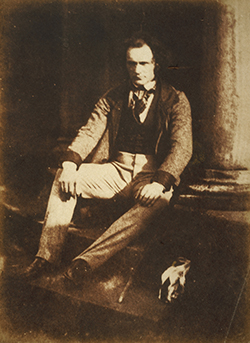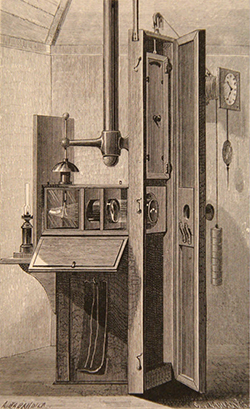MENU
The Electronic Scholarly Publishing Project: Providing access to classic scientific papers and other scholarly materials, since 1993. More About: ESP | OUR CONTENT | THIS WEBSITE | WHAT'S NEW | WHAT'S HOT
Comparative Timelines
The ESP Timeline (one of the site's most popular features) has been completely updated to allow the user to select (using the timeline controls above each column) different topics for the left and right sides of the display.
Select:
New Left Column
New Left Column
Dates
Decade
New Right Column
New Right Column
 Alexandre-Edmond Becquerel shows that light can initiate chemical reactions that produce an electric current.
Alexandre-Edmond Becquerel shows that light can initiate chemical reactions that produce an electric current.
1840
(no entry for this year)
1841
 William Henry Talbot patents the Calotype process, the first negative-positive process making possible the first multiple copies.
William Henry Talbot patents the Calotype process, the first negative-positive process making possible the first multiple copies.
 Henry Fox Talbot introduces his patented calotype (or "talbotype") paper negative process, an improved version of his earlier process that greatly reduces the required exposure time.
Henry Fox Talbot introduces his patented calotype (or "talbotype") paper negative process, an improved version of his earlier process that greatly reduces the required exposure time.
 German physician and physicist Julius Robert Mayer is the first to state the law of conservation of energy, noting specifically that heat and mechanical energy are two aspects of the same thing.
German physician and physicist Julius Robert Mayer is the first to state the law of conservation of energy, noting specifically that heat and mechanical energy are two aspects of the same thing.
 On the uniform motion of heat in homogeneous solid bodies, by William Thomson, aka Lord Kelvin (1824-1907), is published. Thomson's concern with the physics of cooling bodies will draw him into debates concerning the age of the Earth. In 1846 he calculates that the Earth can be no more than 100 million years old.
On the uniform motion of heat in homogeneous solid bodies, by William Thomson, aka Lord Kelvin (1824-1907), is published. Thomson's concern with the physics of cooling bodies will draw him into debates concerning the age of the Earth. In 1846 he calculates that the Earth can be no more than 100 million years old.
 The change in the observed frequency of waves emitted from a source, moving relative to the observer, is described by Christian Johann Doppler (1803-1853). This phenomenon is now known as the Doppler Effect.
The change in the observed frequency of waves emitted from a source, moving relative to the observer, is described by Christian Johann Doppler (1803-1853). This phenomenon is now known as the Doppler Effect.
1842
(no entry for this year)
 James Prescott Joule determines the mechanical equivalent of heat by measuring the rise in temperature produced in water by stirring it.
James Prescott Joule determines the mechanical equivalent of heat by measuring the rise in temperature produced in water by stirring it.
1843
(no entry for this year)
(no entry for this year)
1844
(no entry for this year)
 Michael Faraday relates magnetism to light after finding the magnetic field effects the polarization of light in crystals. He proposes that light may be waves of electromagnetism. He also describes the phenomena of diamagnetism and paramagnetism, which he explains in terms of his concept of a magnetic field.
Michael Faraday relates magnetism to light after finding the magnetic field effects the polarization of light in crystals. He proposes that light may be waves of electromagnetism. He also describes the phenomena of diamagnetism and paramagnetism, which he explains in terms of his concept of a magnetic field.
1845
 Francis Ronalds invents the first successful camera for continuous recording (the first "movie camera") of the variations in meteorological and geomagnetic parameters over time. A copy of Ronalds' paper describing describing his device maybe obtained HERE.
Francis Ronalds invents the first successful camera for continuous recording (the first "movie camera") of the variations in meteorological and geomagnetic parameters over time. A copy of Ronalds' paper describing describing his device maybe obtained HERE.
 James Prescott Joule discovers that the length of an iron bar changes slightly when the bar is magnetized.
James Prescott Joule discovers that the length of an iron bar changes slightly when the bar is magnetized.
1846
(no entry for this year)
 Über die Erhaltung der Kraft ("On the Conservation of Force"), by Hermann Ludwig von Helmholtz (1821-1894), is published. It articulates what later becomes known as the Conservation of Energy.
Über die Erhaltung der Kraft ("On the Conservation of Force"), by Hermann Ludwig von Helmholtz (1821-1894), is published. It articulates what later becomes known as the Conservation of Energy.
1847
(no entry for this year)
 An absolute scale of temperatures is proposed by William Thomson (1824-1907). Thomson will become Baron Kelvin of Largs, in 1892, and the scale will come to bear his name.
An absolute scale of temperatures is proposed by William Thomson (1824-1907). Thomson will become Baron Kelvin of Largs, in 1892, and the scale will come to bear his name.
 Armand Hippolyte Louis Fizeau suggests that light from a source of moving away from the observer will be shifted toward the red end of the spectrum, a phenomenon known as redshift. This is closely related to, but not exactly the same as, the Doppler effect.
Armand Hippolyte Louis Fizeau suggests that light from a source of moving away from the observer will be shifted toward the red end of the spectrum, a phenomenon known as redshift. This is closely related to, but not exactly the same as, the Doppler effect.
1848
 Edmond Becquerel makes the first full-color photographs, but they are only laboratory curiosities: an exposure lasting hours or days is required and the colors are so light-sensitive that they sometimes fade right before the viewer's eyes while being examined.
Edmond Becquerel makes the first full-color photographs, but they are only laboratory curiosities: an exposure lasting hours or days is required and the colors are so light-sensitive that they sometimes fade right before the viewer's eyes while being examined.
 Armand Hippolyte Louis Fizeau measures the velocity of light in error by measuring the time it takes for a beam of light to pass between the teeth of a rotating gear. The light is reflected by a mirror and stopped by the next tooth of the gear. The result, 315,000 km/se4c (196,000 miles/sec), is within 5% of today's accepted value.
Armand Hippolyte Louis Fizeau measures the velocity of light in error by measuring the time it takes for a beam of light to pass between the teeth of a rotating gear. The light is reflected by a mirror and stopped by the next tooth of the gear. The result, 315,000 km/se4c (196,000 miles/sec), is within 5% of today's accepted value.
 In describing Sadi Carnot's theory of heat, published in 1824, William Thomson (1824-1907) uses the term THERMODYNAMICS.
In describing Sadi Carnot's theory of heat, published in 1824, William Thomson (1824-1907) uses the term THERMODYNAMICS.
 The speed of light is measured by physicist Armand Hippolyte Louis Fizeau (1819-1896) to be approximately 186,000 miles per second.
The speed of light is measured by physicist Armand Hippolyte Louis Fizeau (1819-1896) to be approximately 186,000 miles per second.
1849
(no entry for this year)
ESP Quick Facts
ESP Origins
In the early 1990's, Robert Robbins was a faculty member at Johns Hopkins, where he directed the informatics core of GDB — the human gene-mapping database of the international human genome project. To share papers with colleagues around the world, he set up a small paper-sharing section on his personal web page. This small project evolved into The Electronic Scholarly Publishing Project.
ESP Support
In 1995, Robbins became the VP/IT of the Fred Hutchinson Cancer Research Center in Seattle, WA. Soon after arriving in Seattle, Robbins secured funding, through the ELSI component of the US Human Genome Project, to create the original ESP.ORG web site, with the formal goal of providing free, world-wide access to the literature of classical genetics.
ESP Rationale
Although the methods of molecular biology can seem almost magical to the uninitiated, the original techniques of classical genetics are readily appreciated by one and all: cross individuals that differ in some inherited trait, collect all of the progeny, score their attributes, and propose mechanisms to explain the patterns of inheritance observed.
ESP Goal
In reading the early works of classical genetics, one is drawn, almost inexorably, into ever more complex models, until molecular explanations begin to seem both necessary and natural. At that point, the tools for understanding genome research are at hand. Assisting readers reach this point was the original goal of The Electronic Scholarly Publishing Project.
ESP Usage
Usage of the site grew rapidly and has remained high. Faculty began to use the site for their assigned readings. Other on-line publishers, ranging from The New York Times to Nature referenced ESP materials in their own publications. Nobel laureates (e.g., Joshua Lederberg) regularly used the site and even wrote to suggest changes and improvements.
ESP Content
When the site began, no journals were making their early content available in digital format. As a result, ESP was obliged to digitize classic literature before it could be made available. For many important papers — such as Mendel's original paper or the first genetic map — ESP had to produce entirely new typeset versions of the works, if they were to be available in a high-quality format.
ESP Help
Early support from the DOE component of the Human Genome Project was critically important for getting the ESP project on a firm foundation. Since that funding ended (nearly 20 years ago), the project has been operated as a purely volunteer effort. Anyone wishing to assist in these efforts should send an email to Robbins.
ESP Plans
With the development of methods for adding typeset side notes to PDF files, the ESP project now plans to add annotated versions of some classical papers to its holdings. We also plan to add new reference and pedagogical material. We have already started providing regularly updated, comprehensive bibliographies to the ESP.ORG site.
ESP Picks from Around the Web (updated 06 MAR 2017 )
Old Science

Weird Science

Treating Disease with Fecal Transplantation
Fossils of miniature humans (hobbits) discovered in Indonesia

Dinosaur tail, complete with feathers, found preserved in amber.
Astronomy

Mysterious fast radio burst (FRB) detected in the distant universe.